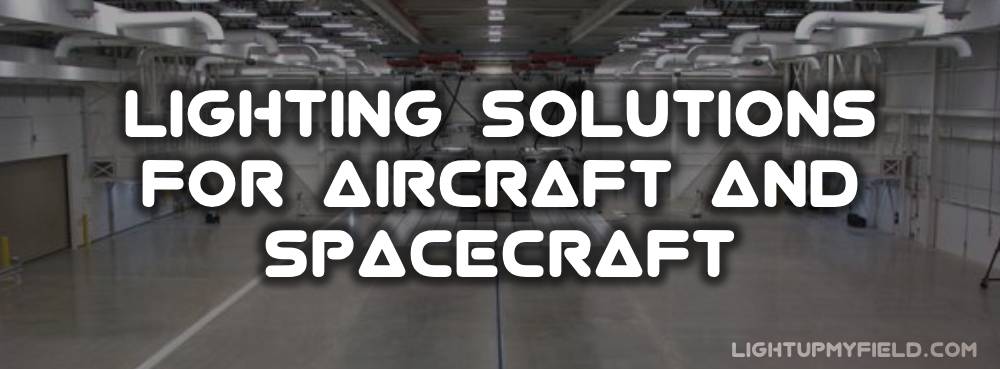Whether it’s for aircraft or spacecraft, the lighting setup plays a major role in safety, efficiency, and even cost. But did you know the lighting needs for aircraft hangars differ quite a bit from those for spacecraft hangars? And that the design approach needs to consider several unique factors? Let’s break down the differences, the design principles, and what you should watch out for when planning lighting in these specialized spaces.
Table of Contents
ToggleWhat’s the Difference Between the Lighting Needs of Aircraft Hangars and Spacecraft Hangars?
You might look at a hangar and just see a giant open space with massive doors — but once you dig deeper, you realize that aircraft and spacecraft hangars actually have pretty different lighting needs. These differences come down to what’s inside, what kind of work gets done there, and even the environment they operate in.
Lighting for Aircraft Hangars – Big Space, Big Tasks
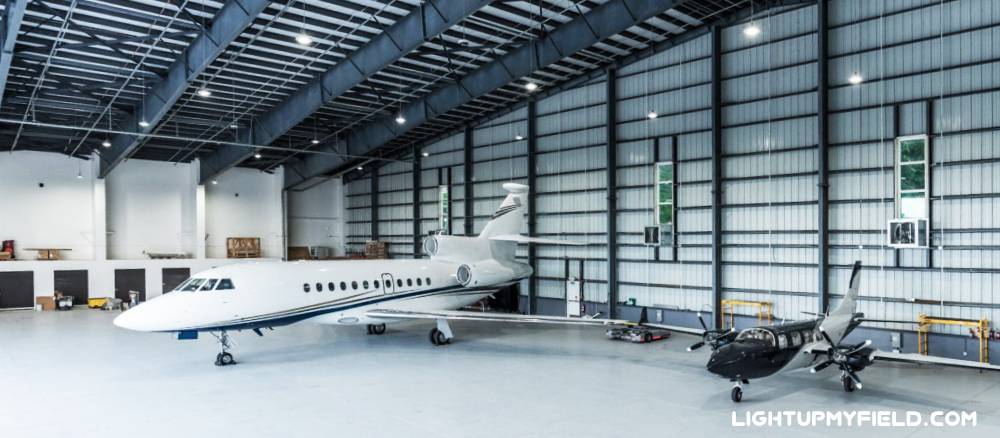
Aircraft hangars usually house commercial airplanes, cargo jets, or private planes. The lighting setup here needs to cover a wide range of activities — from routine maintenance and inspections to refueling and painting. These jobs require solid, reliable illumination, but not just anywhere: different zones might need different lighting intensities. Generally, maintenance areas aim for about 300 to 500 lux, which is bright enough to spot cracks or oil leaks but still comfortable for long shifts.
Because hangar doors often open and close, natural daylight can sneak in and mix with artificial light, which sometimes complicates getting consistent brightness. Plus, with ceilings often soaring 30 to 50 feet or more, lighting fixtures have to be powerful and well-placed to avoid shadows cast by the aircraft’s wings and engines. And since the space is so large — think tens of thousands of square feet in commercial settings — you’ll often see dozens or even hundreds of fixtures working in sync to create that even, shadow-free environment.
Lighting for Spacecraft Hangars – Precision Meets Sensitivity
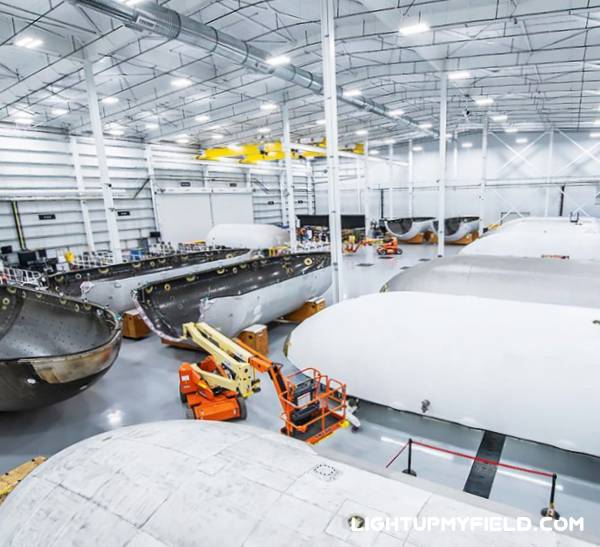 Now, spacecraft hangars are a whole other story. These spaces deal with equipment that can cost billions and require incredible precision and cleanliness. The lighting here isn’t just about brightness — it’s about uniformity, color accuracy, and stability. In fact, the color rendering index (CRI), which measures how accurately a light source reveals colors compared to natural light, usually needs to be above 90. That level of accuracy helps engineers and technicians catch the tiniest flaws, like micro-cracks or subtle color changes on delicate components.
Now, spacecraft hangars are a whole other story. These spaces deal with equipment that can cost billions and require incredible precision and cleanliness. The lighting here isn’t just about brightness — it’s about uniformity, color accuracy, and stability. In fact, the color rendering index (CRI), which measures how accurately a light source reveals colors compared to natural light, usually needs to be above 90. That level of accuracy helps engineers and technicians catch the tiniest flaws, like micro-cracks or subtle color changes on delicate components.
Brightness levels in spacecraft hangars often go beyond what you’d find in aircraft hangars, sometimes reaching 600 to 1000 lux or more, depending on the task. Since assembly might involve microscopic inspections, electronics work, or integration of sensitive instruments, the lighting has to be flicker-free and stable to avoid eye strain and errors.
Another twist? Spacecraft hangars often operate in cleanroom conditions or controlled environments where dust and particles can ruin sensitive components. That means lighting fixtures need to be sealed or dust-tight, and they can’t interfere with delicate instruments by emitting electromagnetic interference (EMI). This rules out some traditional lighting options and makes LEDs with special shielding a popular choice.
Why These Differences Matter
The takeaway? Although both types of hangars are big spaces where large machines are worked on, their lighting needs are tailored to very different challenges. Aircraft hangars prioritize broad, even lighting that handles natural light fluctuations and large ceilings, while spacecraft hangars demand lighting that supports microscopic detail work, environmental control, and exact color accuracy.
Without the right lighting for each setting, you’re risking everything from slower work and fatigue to costly mistakes or even damage to some seriously valuable equipment. So, understanding these differences upfront helps guide smarter lighting choices that make life easier — and safer — for everyone involved.
Lighting Design Principles for Aircraft and Spacecraft Hangars
Getting the lighting setup right in these hangars is about juggling a few important factors — but what those factors actually look like changes depending on whether you’re lighting a plane or a spaceship.
Designing for Aircraft Hangars – Big Space, Even Light
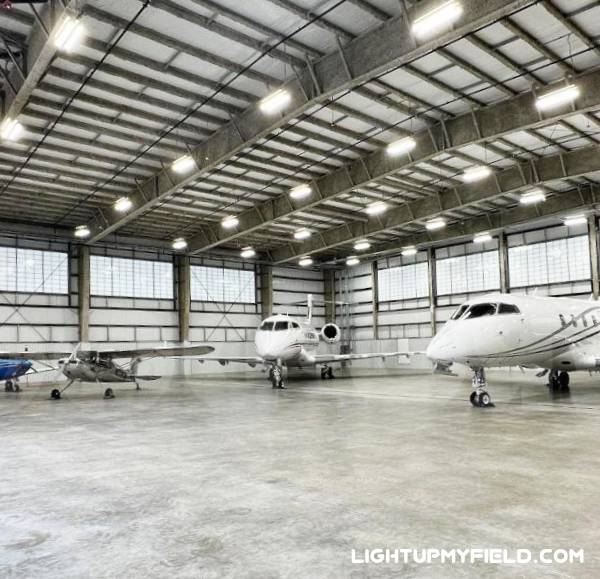 When it comes to aircraft hangars, the goal is to cover a huge area evenly, so crews can move around without bumping into shadows or straining their eyes. Planes are tricky because of all their curves, wings, and landing gear, which can create pockets of shade if the lighting isn’t spot on. That’s why LED high bay fixtures have become the go-to choice — they pack a punch in brightness but stay energy-efficient and last way longer than older bulbs.
When it comes to aircraft hangars, the goal is to cover a huge area evenly, so crews can move around without bumping into shadows or straining their eyes. Planes are tricky because of all their curves, wings, and landing gear, which can create pockets of shade if the lighting isn’t spot on. That’s why LED high bay fixtures have become the go-to choice — they pack a punch in brightness but stay energy-efficient and last way longer than older bulbs.
Since ceilings are often between 30 and 50 feet high, the choice of beam angle and fixture wattage is key. Too narrow a beam and you get bright spots with dark gaps. Too wide, and the light loses punch and might cause glare. The sweet spot usually means picking lights with a beam angle that spreads light just enough to hit the floor evenly, often between 60 and 90 degrees.
Another thing lighting designers look at is uniformity. For aircraft hangars, the ideal uniformity ratio is around 0.7 to 0.8, which means the dimmest part of the space should still be at least 70 to 80 percent as bright as the average level. This keeps crews from getting eye fatigue and helps avoid accidents caused by uneven lighting.
And because hangars aren’t always buzzing 24/7, smart controls like motion sensors and dimmers are super helpful. They can dial down the power in empty areas, saving energy, but snap back to full brightness when people are working. Over time, that adds up to serious savings on electric bills.
Designing for Spacecraft Hangars – Precision and Purity
Spacecraft hangars have a whole different vibe. The lighting here is about precision, quality, and environmental control. These spaces often deal with super detailed inspections where the tiniest flaw can cause big problems later on. So, flicker-free lighting with high color accuracy is the name of the game.
Color temperature usually runs cooler, somewhere between 5000K and 6500K, to mimic natural daylight as closely as possible. This helps technicians see colors true-to-life, which is vital when working with complex wiring, coatings, or sensitive electronics.
Since many spacecraft hangars operate as part of cleanrooms or controlled environments, the lighting fixtures themselves have to be sealed or dust-tight. That means they’re designed to keep out contaminants and fit neatly into the strict environmental rules that keep spacecraft pristine.
Energy efficiency is still a priority, but spacecraft hangar lighting often ties into bigger systems — things like environmental monitoring, security, and facility management all coordinate to maintain the exact conditions needed for these high-stakes operations.
Why the Different Approaches Matter
The takeaway? While aircraft hangars demand lighting that handles a lot of space, complex shapes, and shifting activity, spacecraft hangars zoom in on ultra-precise, stable light that doesn’t mess with the sensitive environment. Both need thoughtful design, but the details you focus on shift quite a bit depending on what’s inside.
Points to Note When Designing the Lighting System for These Hangars
When it comes to lighting huge, specialized spaces like aircraft and spacecraft hangars, a few practical factors really shape how well the whole setup works — and whether it stands the test of time.
Size and Scale – Planning for the Giant Spaces
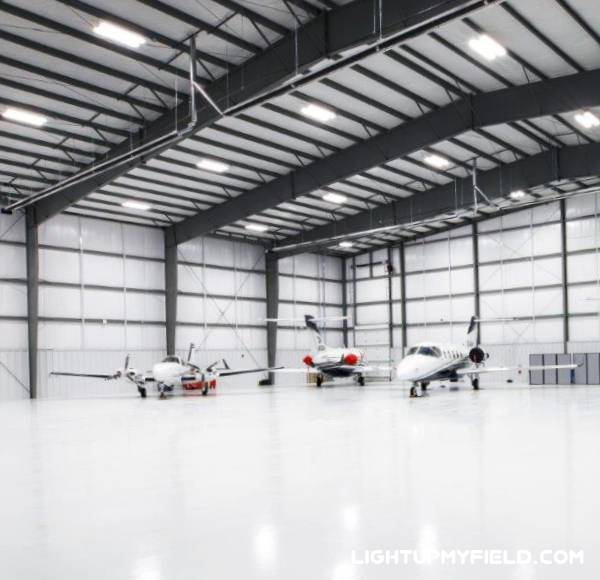 One of the biggest challenges is just how massive these hangars can be. Aircraft hangars often stretch beyond 100,000 square feet, and spacecraft hangars, while sometimes smaller, still cover big footprints. You can’t just slap lights up randomly and hope for the best. These spaces usually call for detailed lighting layouts modeled on computers, making sure there are no dark corners or areas where glare could blind someone. The goal? Keep lighting levels steady around 300 to 500 lux throughout, hitting those sweet spots without going overboard on wattage.
One of the biggest challenges is just how massive these hangars can be. Aircraft hangars often stretch beyond 100,000 square feet, and spacecraft hangars, while sometimes smaller, still cover big footprints. You can’t just slap lights up randomly and hope for the best. These spaces usually call for detailed lighting layouts modeled on computers, making sure there are no dark corners or areas where glare could blind someone. The goal? Keep lighting levels steady around 300 to 500 lux throughout, hitting those sweet spots without going overboard on wattage.
Ceiling Height – Picking the Right Fixtures and Angles
Ceiling height is a huge deal too. For aircraft hangars, where ceilings soar 30 to 50 feet or more, you’ll often see narrow beam angle LED high bays or even long, linear fixtures used to funnel light straight down. The idea is to avoid light scattering and losing intensity before it reaches the floor where work happens.
Spacecraft hangars might have lower ceilings or a more segmented layout, which means you’re better off with smaller, precision lighting that can be focused on specific work zones without flooding the whole room with unnecessary brightness.
Task-Specific Needs – Matching Lighting to Work
The kind of work happening inside the hangar really dictates the lighting setup. For aircraft maintenance or inspections, you want lighting with high color rendering (CRI 80+) to help workers spot cracks, leaks, or other issues easily. Shadow control also matters here — uneven light can hide flaws or cause safety hazards.
In storage or parking zones, you can relax a bit and use softer, more diffuse lighting because those areas don’t need the same level of detail. But spacecraft hangars take it to another level. Since they often deal with sensitive electronic assembly, lighting needs to be anti-static or shielded to avoid electromagnetic interference, which could disrupt delicate instruments or cause errors.
Energy Efficiency and Operational Savings
Energy use can get expensive fast, especially when lights run 14 hours a day or more. That’s why LEDs have become the go-to choice — they typically use 50 to 70% less electricity than older metal halide or fluorescent setups. Plus, their long lifespan, often between 50,000 to 100,000 hours, means fewer lighting replacements, less downtime, and lower maintenance costs.
Smart controls are another money saver. Motion sensors that turn lights off in empty zones or daylight harvesting systems that dim artificial light when enough sunlight is coming in can slice another 20 to 30% off energy bills. Over time, these efficiencies add up to big savings.
Installation and Maintenance – Planning for Practical Realities
Hangars aren’t easy to work in, especially when you’re installing or swapping out lights that hang from super high ceilings. You’ll likely need lifts or scaffolding, which adds time and cost to any project.
That’s why designing the lighting system with longevity and ease of maintenance in mind is a smart move. Fixtures rated for 50,000 hours or more reduce how often you need to bring out the gear for replacements or repairs, saving hassle and downtime.
Navigating Safety Standards and Industry Codes
No lighting plan is complete without thinking about the rules. Aircraft hangars often follow standards like ASHRAE 90.1 for energy efficiency and the FAA’s lighting guidelines to ensure safety and performance.
Spacecraft facilities have their own playbooks. Agencies like NASA or ESA, along with private space companies, often enforce specific lighting requirements, sometimes tied to cleanroom classifications or electromagnetic compatibility standards. Ignoring these can lead to costly rework or even operational shutdowns.
How Lighting Impacts Safety and Efficiency
Lighting in a hangar isn’t just about making the place look bright — it plays a big role in how safely and smoothly work gets done. When the lighting isn’t up to snuff, it can lead to costly mistakes during inspections or maintenance. Imagine a tiny crack or a loose bolt missed because the light was too dim or uneven. Those kinds of oversights can cost millions in repairs, not to mention potential safety hazards.
Reducing Human Error and Fatigue
Good lighting helps reduce eye strain and fatigue, which is huge when crews are pulling long shifts working on complex machinery. When your eyes don’t have to work overtime to see details, you stay sharper, make fewer mistakes, and get more done. Bright, uniform lighting also helps improve overall morale — working under harsh, flickering lights can be draining and frustrating.
The High Stakes in Spacecraft Hangars
The bar gets even higher in spacecraft hangars. Here, even a small shadow or glare could hide a flaw on something as crucial as a heat shield, or cause a technician to misread delicate electronics during testing. Lighting with the wrong color temperature or poor color rendering can disguise subtle defects that only show up once the spacecraft is in orbit — and by then, it’s way too late to fix.
Money Saved Through Efficiency
On top of safety and quality, lighting also affects the bottom line. Older lighting setups, especially metal halide or fluorescent systems, can burn through thousands of dollars a month in electricity and replacement bulbs alone. Those old lamps don’t just guzzle power; they also wear out faster, meaning more downtime and maintenance costs.
Switching to modern LEDs with smart controls like occupancy sensors or daylight dimming can often pay for themselves within just a few years. They use way less energy — up to 70% less — and last several times longer, cutting both power bills and maintenance headaches.
Bright Ideas Moving Forward
If you’re involved in designing or upgrading hangar lighting, start by getting a solid handle on the space’s purpose and constraints. Factor in the size, ceiling height, tasks, and sensitivity of the work being done. From there, lean into LED technology, smart controls, and tailored lighting designs that meet or exceed recommended lux and CRI levels.
And remember, a lighting system is more than just fixtures—it’s part of an integrated workspace that supports the people and technology inside.
The right lighting setup can transform a hangar from a dim, inefficient space into a well-lit, safe, and cost-effective hub for keeping aircraft and spacecraft mission-ready.

